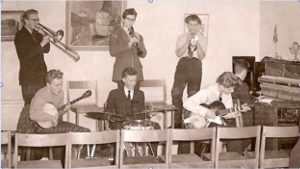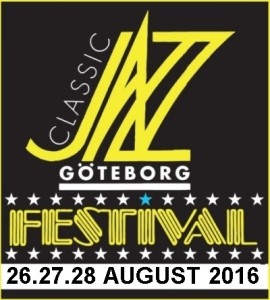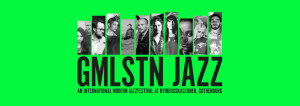A report from Merja Liimatainen, University of Gothenburg
According to the members of the Classic Jazz society, Gothenburg is the New Orleans of the Nordic countries. When jazz music became known over large parts of the world in the 1920s and 1930s, it also found its way to Sweden. Jazz music probably came to Gothenburg via Svenska Amerikalinjen, the New York-Gothenburg shipping line. Gothenburg was thereby jazz music’s first port of call in Sweden.
“One important contributing factor was that we had the “America ships” here in Gothenburg and Swedish musicians took jobs on these boats purely so as to be able to get across to New York and go and listen to famous jazz musicians, buy records and bring them back to Sweden. Likewise, many of the jazz bands from the USA came over on the ships to Sweden and often played in Gothenburg when the ships were berthed in the port.” (Tom, Classic Jazz society)
Around 1920, there were several foreign bands in Gothenburg and probably local bands as well that played at underground clubs, restaurants and cafés. At that time, jazz was associated with modernity, sophistication and decadence. This part of the city’s jazz history has been very sparsely documented. The main focus has been on the 1940s and 1950s which was the heyday period of traditional jazz music in Sweden. By then, musical influences were coming from England, not New York. The Swedish term tradjazz comes from the English term traditional jazz. Referring to Dixieland, Tom explains that many influences have been exchanged between Gothenburg and London and there were strong links between jazz scenes.
“That is perhaps why the music that is called traditional or classical jazz has been somewhat more firmly anchored here in Gothenburg than in Stockholm and many musicians here play in the same way as this kind of jazz was played in England.” (Tom, Classic Jazz)
The 1940s: the wave of traditional jazz

The 1940s saw the start of the era that Ingemar, another of Classic Jazz’s mainstays, calls the revival period. The young musicians of that time went back to the roots of jazz music in order to rediscover the original and genuine style of jazz and revive the music that black musicians played in New Orleans in the early 20th century. It was during the revival period that modern jazz, bebop, came to Gothenburg. This was also a reaction against “commercial” swing music. Ingemar explains that bebop changed jazz from dance-friendly popular music to innovative art, the music of musicians, that is to say, music to be listened to which was regarded even then as being of a better and finer class than the old, traditional jazz. Both camps believed they were “tremendously hip” in the early 1950s. At the same time, people were not so obsessed with different styles initially. There were several jazz competitions where the same musicians could perform in both the modern and Dixie categories.
Today, there are no active bands from the 1940s anymore. My informants and many of the Classic Jazz society’s active musicians and members were born in that decade. They were not active on Gothenburg’s jazz scene until they were teenagers in the 1950s and 1960s.
The 1950s: the golden era of school band jazz
“This is for those of you who remember the school dances of the 50s and 60s” proclaimed one of the members of Peoria Jazzband from the stage at a jazz evening on S/S Marieholm, organised by the Classic Jazz Göteborg society. In the 1950s, most musicians and traditional jazz bands got to know each other at upper secondary school and they started out by playing at school dances. Later, new constellations could arise via meetings and jam sessions at jazz clubs.

It was almost exclusively young men who played in these bands. Most of the traditional jazz musicians were self-taught and after upper secondary school and then studies at university/college, some of them continued to play in their spare time alongside their professional careers. For most of them, music-making has never been a job; it’s been a hobby that has been pursued together with the people they socialised with. Several of the people who started playing in school bands at the end of the 50s and in the early 60s are now members of the Classic Jazz Göteborg society.
In 1950, Gothenburg’s most talked about and famous traditional/ revival jazz band, Landala Original Red Hot Stompers, was started up (1950-1969). The band is described as being a collective of art students and Valand pupils who played New Orleans/revival jazz and lived together in Kåken, a large, dilapidated house in an old part of Gothenburg. The house became a meeting place for art students, artists, writers, actors and bohemians in Gothenburg. It no longer exists today, nor are there any recordings of Landala Original Red Hot Stompers. The band played for the last time at the end of the 1960s, at a time when pop and rock music had begun to take over more and more of the music scene and had become the new popular music in Gothenburg. Jazz began to be increasingly seen as being highbrow culture and art music. Very few traditional jazz bands survived but Peoria (1960) and Tant Bertas Jasskapell (1963), founded in the early 1960s, are two of the oldest traditional jazz bands in Gothenburg that are still active today.
1970s and 1980s: a new chapter
In the 1970s, school band musicians from the 50s and 60s had grown up and many of them had left the jazz scene or gone over to other forms of music. In 1977, the Tradjazz Göteborg society was founded; it later changed its name to Classic Jazz Göteborg. The Jazzhuset club organised many activities including jazz evenings several times a week. In 1988, the owner of Jazzklubben, Ulf Albrektsson, organised the first jazz festival in Gothenburg, Tradjazzfestivalen i Göteborg, which was the predecessor of today’s Göteborg Classic Jazz festival. In the 1990s, Jazzhuset was struck by the recession, the changing tastes of the general public and declining audiences which led to 1960s rock music coming back and taking over the scene. By the end of the 1990s, there was no longer any jazz at all in Jazzhuset. Since the 1990s, traditional jazz has been called “rocking chair jazz” and is viewed as “no longer being culture” in the media and by reviewers. Nevertheless, every year Classic Jazz organises a handful of activities that are linked to classical/traditional jazz in Gothenburg: jazz evenings on S/S Marieholm, jazz cruises to Denmark, summer jazz in the city’s parks and church concerts. Little attention is paid to these activities by the “official” Gothenburg and the city’s cultural elite. There is also a new generation of young musicians and bands, such as The Gentlemen & Gangsters. This band plays traditional New Orleans hot jazz with a touch of swing. Playing mainly for the lindy hop community, they perform all over Europe on a regular basis.
An interesting closing comment is that up to now, the jazz history of the city has been written almost exclusively by men and about men, but women have always been present as dancing partners, listeners, mothers, wives, girlfriends and daughters with their own memories. From the perspective of cultural history, people who have been on the side-lines of the traditional jazz scene should also be given their fair share of space in the history of jazz.
Translated by Helene Brembeck
Reference
Wågerman, Ingemar (2010) Down by the Riverside: den traditionella jazzen i Göteborg med omnejd. Hönö: Ingemar Wågerman









